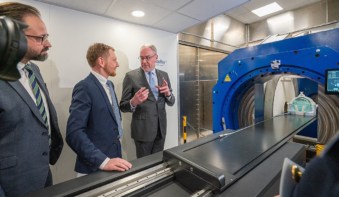Physicists in Greece, Australia and Russia have made a new form of carbon that has the lowest density ever reported for a solid – just 2 milligrams per cubic centimetre. The material is a nano-foam of carbon clusters and is the first form of pure carbon to display ferromagnetism, albeit temporary, at room temperature. The team, which presented its results at a meeting of the American Physical Society in Montreal yesterday, says the foam could be used for spintronic applications and in medical imaging (A Rode et al. 2004 arxiv.org/pdf/cond-mat/0310751).
John Giapintzakis of the University of Crete, Andrei Rode of the Australian National University in Canberra and colleagues in Crete, Canberra and the Ioffe Physico-Technical Institute in St Petersburg blasted a high-power ultrafast laser onto an extremely pure glassy carbon target in an argon environment. They collected the carbon nano-foam that was produced in a fused silica tube. According to Giapintzakis the laser facility in Canberra is the only facility in the world capable of making the material.
Using electron microscopy, the team observed that the nano-foam consists of randomly interconnected carbon clusters with average diameters of between 6 to 9 nanometres arranged in a web-like structure. The Greek-Australian-Russian team also found that the nano-foam was semiconducting with a band gap of 0.5 to 0.7 electronvolts. Moreover, freshly produced foam had a strong permanent magnetic moment at room temperature, but this disappeared within a few hours. The material has a Curie temperature – the temperature below which it becomes ferromagnetic – of 90 Kelvin.
The team says that the combination of the narrow band gap and a high Curie temperature could prove useful in spintronics applications. Tiny ferromagnetic clusters of the material could also be injected into blood vessels to improve the quality of magnetic resonance images.
“The novel magnetic behaviour found in this material could also occur in other nanostructured solids,” Giapintzakis told PhysicsWeb. “We have preliminary indications that it occurs in another compound comprised of two non-magnetic elements, boron and nitrogen.” The team now plans to optimise their fabrication technique to create nano-foams whose initial ferromagnetic properties last longer.



